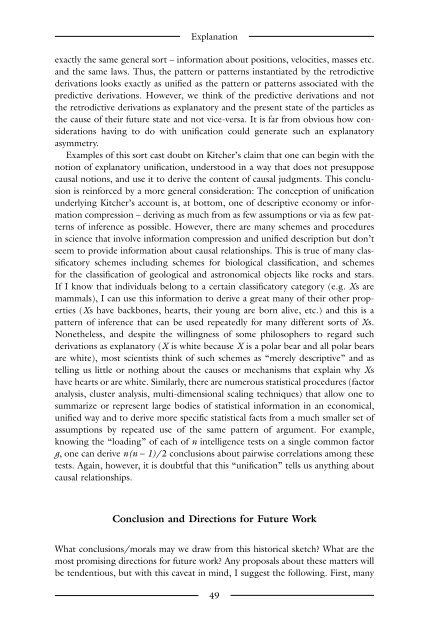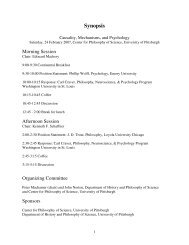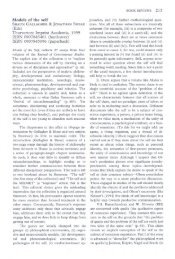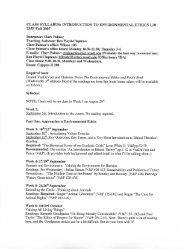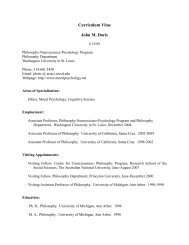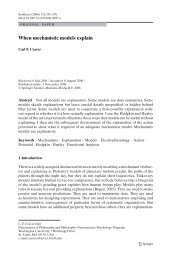The Blackwell Guide to the Philosophy of Science - The Department ...
The Blackwell Guide to the Philosophy of Science - The Department ...
The Blackwell Guide to the Philosophy of Science - The Department ...
You also want an ePaper? Increase the reach of your titles
YUMPU automatically turns print PDFs into web optimized ePapers that Google loves.
Explanation<br />
exactly <strong>the</strong> same general sort – information about positions, velocities, masses etc.<br />
and <strong>the</strong> same laws. Thus, <strong>the</strong> pattern or patterns instantiated by <strong>the</strong> retrodictive<br />
derivations looks exactly as unified as <strong>the</strong> pattern or patterns associated with <strong>the</strong><br />
predictive derivations. However, we think <strong>of</strong> <strong>the</strong> predictive derivations and not<br />
<strong>the</strong> retrodictive derivations as explana<strong>to</strong>ry and <strong>the</strong> present state <strong>of</strong> <strong>the</strong> particles as<br />
<strong>the</strong> cause <strong>of</strong> <strong>the</strong>ir future state and not vice-versa. It is far from obvious how considerations<br />
having <strong>to</strong> do with unification could generate such an explana<strong>to</strong>ry<br />
asymmetry.<br />
Examples <strong>of</strong> this sort cast doubt on Kitcher’s claim that one can begin with <strong>the</strong><br />
notion <strong>of</strong> explana<strong>to</strong>ry unification, unders<strong>to</strong>od in a way that does not presuppose<br />
causal notions, and use it <strong>to</strong> derive <strong>the</strong> content <strong>of</strong> causal judgments. This conclusion<br />
is reinforced by a more general consideration: <strong>The</strong> conception <strong>of</strong> unification<br />
underlying Kitcher’s account is, at bot<strong>to</strong>m, one <strong>of</strong> descriptive economy or information<br />
compression – deriving as much from as few assumptions or via as few patterns<br />
<strong>of</strong> inference as possible. However, <strong>the</strong>re are many schemes and procedures<br />
in science that involve information compression and unified description but don’t<br />
seem <strong>to</strong> provide information about causal relationships. This is true <strong>of</strong> many classifica<strong>to</strong>ry<br />
schemes including schemes for biological classification, and schemes<br />
for <strong>the</strong> classification <strong>of</strong> geological and astronomical objects like rocks and stars.<br />
If I know that individuals belong <strong>to</strong> a certain classifica<strong>to</strong>ry category (e.g. Xs are<br />
mammals), I can use this information <strong>to</strong> derive a great many <strong>of</strong> <strong>the</strong>ir o<strong>the</strong>r properties<br />
(Xs have backbones, hearts, <strong>the</strong>ir young are born alive, etc.) and this is a<br />
pattern <strong>of</strong> inference that can be used repeatedly for many different sorts <strong>of</strong> Xs.<br />
None<strong>the</strong>less, and despite <strong>the</strong> willingness <strong>of</strong> some philosophers <strong>to</strong> regard such<br />
derivations as explana<strong>to</strong>ry (X is white because X is a polar bear and all polar bears<br />
are white), most scientists think <strong>of</strong> such schemes as “merely descriptive” and as<br />
telling us little or nothing about <strong>the</strong> causes or mechanisms that explain why Xs<br />
have hearts or are white. Similarly, <strong>the</strong>re are numerous statistical procedures (fac<strong>to</strong>r<br />
analysis, cluster analysis, multi-dimensional scaling techniques) that allow one <strong>to</strong><br />
summarize or represent large bodies <strong>of</strong> statistical information in an economical,<br />
unified way and <strong>to</strong> derive more specific statistical facts from a much smaller set <strong>of</strong><br />
assumptions by repeated use <strong>of</strong> <strong>the</strong> same pattern <strong>of</strong> argument. For example,<br />
knowing <strong>the</strong> “loading” <strong>of</strong> each <strong>of</strong> n intelligence tests on a single common fac<strong>to</strong>r<br />
g, one can derive n(n - 1)/2 conclusions about pairwise correlations among <strong>the</strong>se<br />
tests. Again, however, it is doubtful that this “unification” tells us anything about<br />
causal relationships.<br />
Conclusion and Directions for Future Work<br />
What conclusions/morals may we draw from this his<strong>to</strong>rical sketch? What are <strong>the</strong><br />
most promising directions for future work? Any proposals about <strong>the</strong>se matters will<br />
be tendentious, but with this caveat in mind, I suggest <strong>the</strong> following. First, many<br />
49


